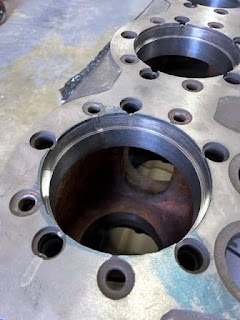Much of the progress over the last five months has been boring. Literally. Probably used the joke before but I don’t care as the task of drilling the holes to allow the body to be assembled is nearing an end. Forming the lovely, new rectangular components was something that Boston Lodge is well set up for, as it has a large guillotine. Many of the sheet steel components are connected by rolled steel angles and while we have been able to recover one (as described in the 14th January 2023 blog entry) the others are too far wasted for re-use. Several of these angles are rolled to some quite tight radii, and require some skill to form them. In addition the main body wrapper, with its distinct ‘air-smoothed’ appearance is too corroded for re-use.
With the arrival of the wrapper, from Richards Sheet Metal the body started to move from being a series of one-dimensional components into something more tangible.

The recovered angle which connects the wrapper to the right hand side panel was soon trial fitted to find that the radii are beautiful match.

The other angle was too heavily corroded for re-use and a replacement has been manufactured by Chris Brady, a blacksmith from Tudweiliog.

Chris has also formed up a new angle hoop to connect the body to the cab, the very rusty remains of which were illustrated in the 14th January 2023 entry.

The body hatches (both top and front) are formed of two angle rings, one attached to the body, the other to the hatch which sit on top of each other. Chris has made these too and four more lovely pieces of angle iron you have never seen in your life.

The photo below shows the new, rear angle hoop and upper wrapper meeting the old side panel and angle. There is a rivet that attaches the angle to the side panel that needs to go in before the hoop is fitted.
After mucho drilling, the body is now a thing. The cut outs for the hatches have been partially laser cut, but left in situ to ensure that the body has some rigidity before the angle rings (which will add a lot of strength) are fitted.

The covers for the hatches have been ordered as laser cut parts. Here is Ben Boulter drilling even more holes to fasten the covers to the angle rings. The original front cover can also be seen in the photo, being used as a point of reference.

One of the cab side panels had some corrosion at the bottom. Chris ‘Rimmer’ Barry is seen here with the guillotine, about to remove a strip which has subsequently been replaced with new material.

A very tidy, massive rectangular hole had been cut into the other cab side at some stage in the past, so that has been replaced. The photo below shows the all new, right hand cab side, which is again full height for the first time since 1929.

Both cab and bonnet are rather large items to store in a workshop, so they have been temporarily mounted on the chassis. While we are quite pleased with the amount of original body that has been recovered (painted red oxide in the photo below) the amount of new steel added is all to apparent. In this view of the left hand side the new strip of steel grafted in to the lower can side can be noted.

The yellow blob on the cab side is a quick 'works plate'. There are two sets of holes, the outer holes are for the longer, elliptical Kerr, Stuart plates and the inner ones for the Hunslet/ Robert Hudson plates fitted in 1934.

Don’t buy a second hand car from Hunslets! In 1934 they were passing off second hand goods as new!

Dewi Atherton has machined up the replacement sliders for the shutters

This is the one good shutter slider that is fit for re-use attached to the replacement right hand side cab sheet

On the left hand side, the lower cab sheet is original but both shutter sliders are new. Seen here with a trial fitting of the teak shutters Clive Bickley produced in 2019 (see 11 December 2019 blog).

Rob Collins is seen here sanding back filler applied to tidy up some of the worst of the pitting to one of the old body panels.

With the front hatch temporarily fitted and a coat of primer Kerr, Stuart 4415 is quite an impressive beast.

































































